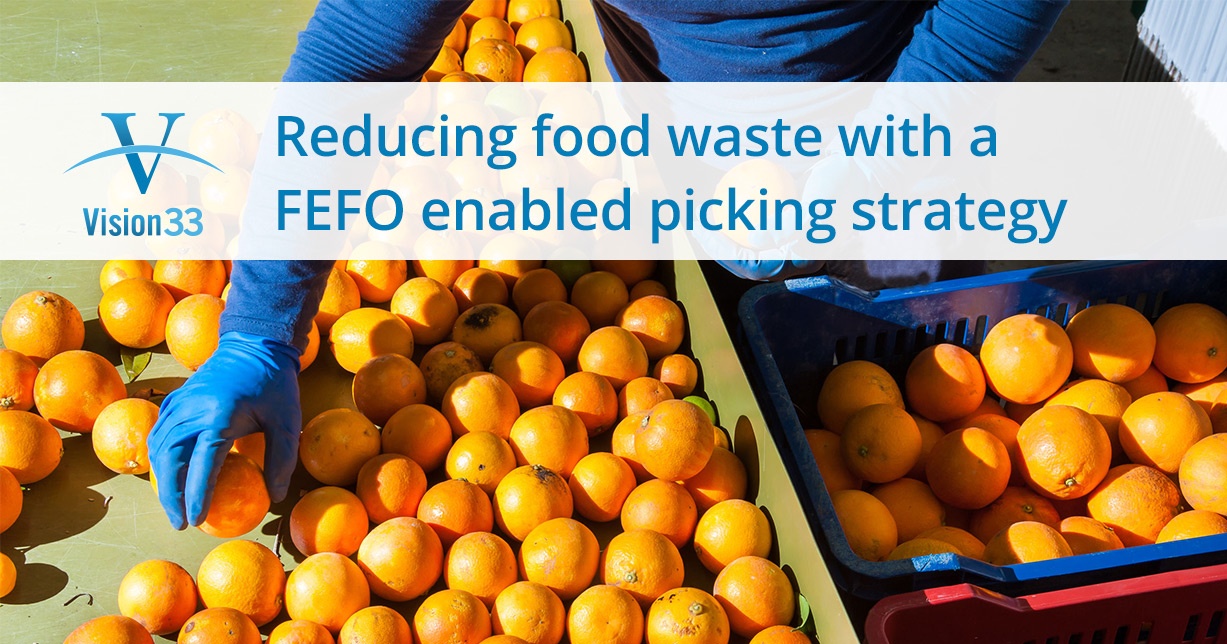Between Farm and Fork, food wastage is substantial and companies must have warehouse management practices in place to maximise shelf life. A FEFO approach with an enterprise resource planning (ERP) solution can help reduce wastage and improve your profitability.

Between Farm and Fork, the economic cost of food wastage is tremendous. In Europe alone, 88 million tons of food is wasted, with an estimated cost of €143 billion. This staggering finding is shared among other countries and if often indicative of developed countries and consumerist lifestyles.
Food and beverage companies often experience a large proportion of food wastage caused by several factors such as overstocking items, inaccurate forecasting, or inappropriate quality control. Consumers expect at least three to five days of shelf life after they purchase a product, and retailers have a role to play in ensuring they meet their customers needs. In the supply chains for perishable products, all partners have a shared responsibility for minimising losses and making sure high-quality products reach the end consumer, in a timely manner. While there are many preservation and packaging techniques to maximise shelf life – it is vital businesses have appropriate warehouse management practices in place. Companies must adopt a strategy that not only considers the rate of deterioration of perishable products, but also the level of demand for it.
A FEFO Solution
A first-expired, first-out, or FEFO approach, ensures products closest to the expiration date in your inventory are shipped out first. This strategy takes into account the remaining shelf life of a product; delivering to retailers well in advance of expiration. An expiration date is assigned to a batch, and this date remains associated to the batch number as products move throughout the supply chain. This method allows expiration and batch information to be tracked within the inventory management system, further identifying which items should be rotated out of inventory first.
The FEFO approach, and the process of batch number tracking, can be especially useful for businesses that receive products that are out of sequence with the receipt date. FEFO can be extended through the warehouse management system as a picking process – as workers are automatically directed to choose items closest to the expiration first.
Obstacles to FEFO Adoption
The FIFO method for inventory management is a common approach used because it’s a simpler system. It is a more common capability found in warehouse management software, however it lacks the intelligence to manage the shelf life of perishable products. The challenge with this method is that consumers’ expectations are changing, and shoppers are demanding more information about the products they are purchasing. Expiration dates affect purchase decisions, and the first-in-first-out (FIFO) approach doesn’t support the ability to determine expiry dates. Given the changing retail landscape, and the limitations of the FIFO approach, why haven’t more food manufacturers and distributors switched to FEFO?
Company Buy-In
Often business owners naturally tend to follow the path of least resistance, and the adoption of a FEFO strategy demands a change in mind-set. In addition, space optimisation can become an issue if workers fail to put products in appropriate bins or support the rotation of products to customers. If an employee simply takes the first product available, older products run the risk of expiring in the warehouse. Employees need to be on board and fully support the strategy for it to work correctly.
Strong warehouse management can be a competitive advantage, and best-in-class companies understand this. By getting products to customers faster, they reduce their wastage, improve customer service, and increase their profitability in the long run. Companies need to be made aware of the wider benefits of a FEFO strategy and there needs to be buy in from everyone on the shop floor.
System Support
A FEFO strategy involves systems that can support picking methodologies, and many inventory and warehouse management systems do not have this capability. Because FEFO involves a greater level of complexity, the logistical controls require more intelligence to manage shelf life and reduce product loss.
FEFO – How Does it Work
How does a FEFO solution work for your business? Industry focused warehouse management systems (WMS) can support a FEFO picking strategy by employing a rules engine to automatically generate a pick list based on the first product to expire. The expiration date configuration and shelf life parameters of the product are stored in the material master record, and the WMS looks for the material with the oldest expiration date. Customers’ differing shelf life requirements for the same SKU can be configured against the item master data, taking delivery times into account to ensure service agreements are met. The pick list is then made available electronically through a mobile device. The operator is then directed to the appropriate warehouse bin location to pick against a specific batch and/or SSCC logistics unit.
A FEFO solution allows every aspect of the warehouse to be measured, such as inventory and waste levels. Legacy systems often track expiration dates manually, leaving room for error. With a FEFO system, companies are able to better manage stock levels, resulting in shorter delivery times, longer shelf life, and ultimately an increase in profitability. With an integrated ERP solution, businesses can take advantage of the FEFO approach to warehouse management through its comprehensive picking strategy. SMEs can use the automated logical processes, virtually eliminating manual data entry and human error. With an ERP solution and FEFO enabled system, businesses can better manage the complexities of the supply chain and gain better visibility into customer orders, shipping, and product movement.
To learn more about Vision33’s ERP solution and how it can help you reduce wastage in your company with a FEFO enabled picking strategy, download this solution brief.

